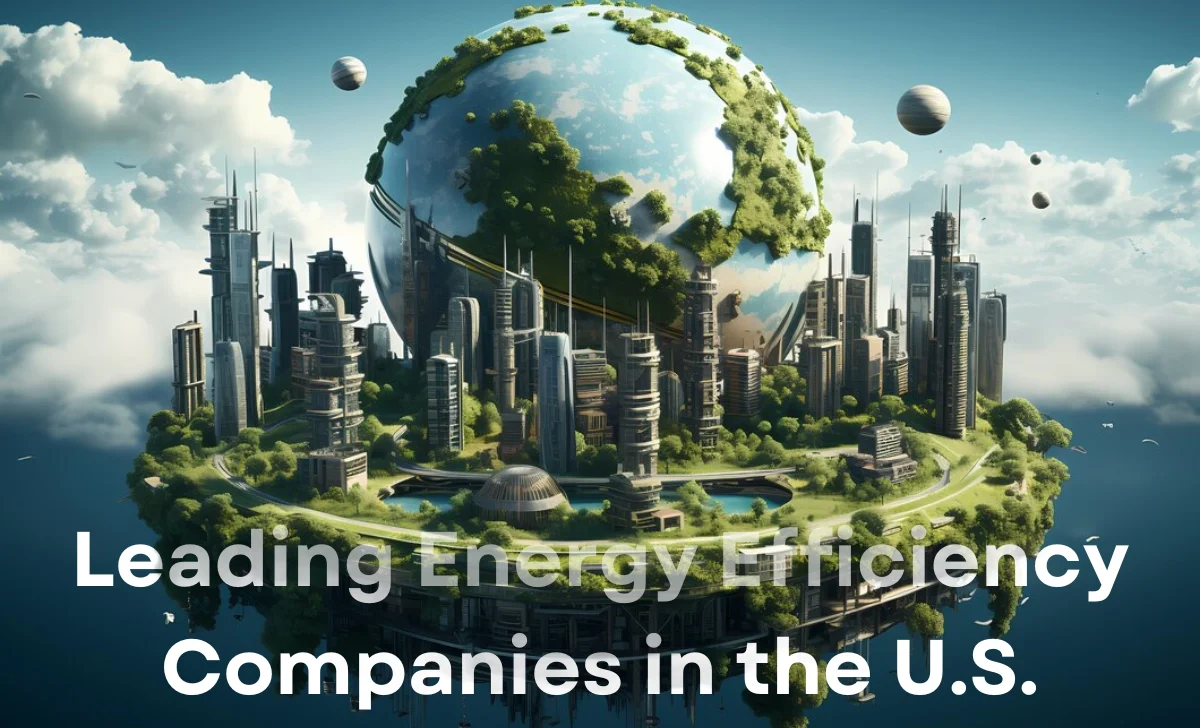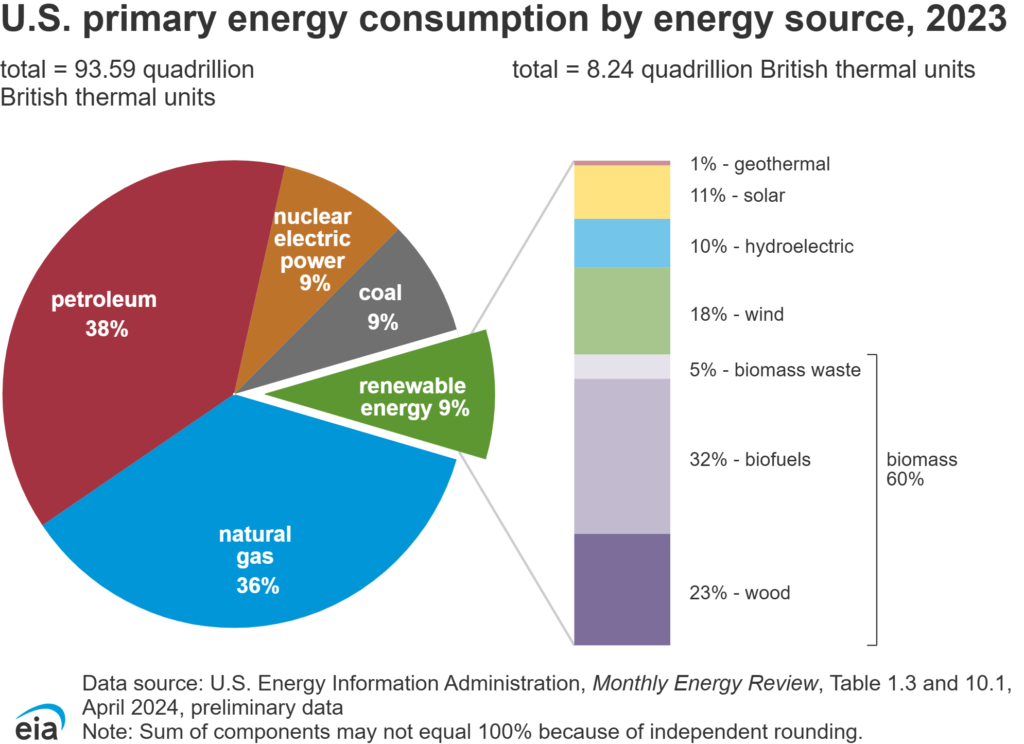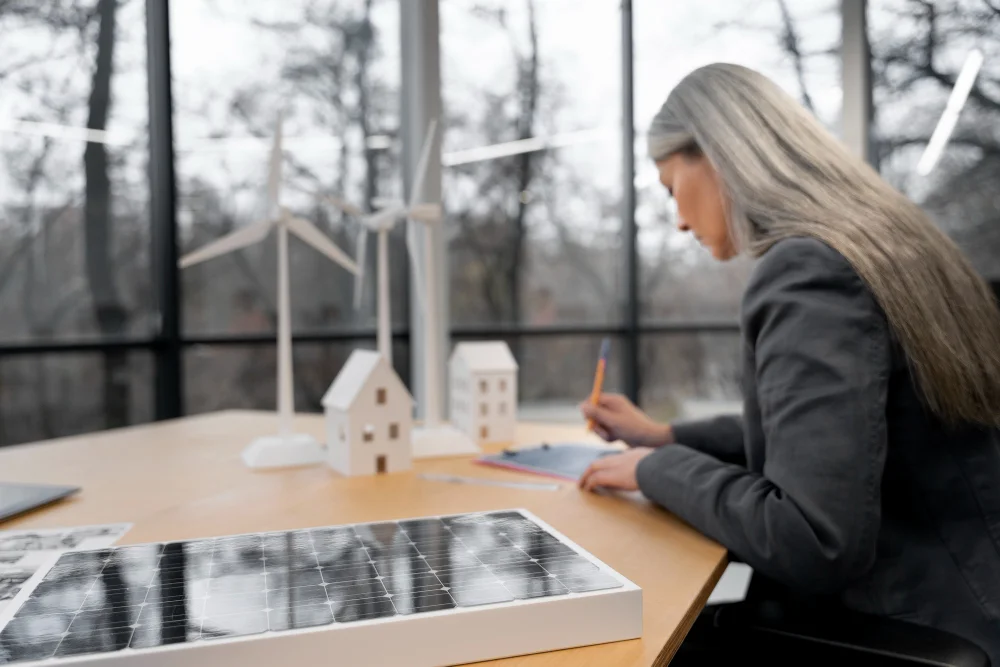
Top Energy Efficiency Companies: Innovations, Case Studies, and Future Trends in the U.S.
Energy efficiency is the practice of utilizing less energy to perform the same tasks, thereby reducing energy waste and lowering costs. In the United States, this approach is crucial for enhancing environmental sustainability, bolstering economic growth, and improving energy security.
The Importance of Energy Efficiency
Implementing energy-efficient measures offers numerous benefits:
- Environmental Impact: By reducing energy consumption, we decrease greenhouse gas emissions, contributing to the fight against climate change.
- Economic Advantages: Energy efficiency can lead to significant cost savings for businesses and homeowners, stimulating economic growth.
- Energy Security: Reducing demand on the energy grid enhances national energy security and resilience.
Current Energy Landscape in the U.S.

As of 2023, the United States produced approximately 102.83 quadrillion British thermal units (quads) of energy, surpassing the 93.59 quads consumed. Despite this surplus, fossil fuels—petroleum, natural gas, and coal—accounted for about 84% of total U.S. primary energy production in 2023.
Role of Energy Efficiency Companies
Energy efficiency companies play a pivotal role in this landscape by developing, designing, and implementing projects that save energy, reduce costs, and decrease operations and maintenance expenses. They act as project developers for a comprehensive range of energy conservation measures (ECMs) and assume the technical and performance risks associated with a project.
Focus on U.S. Energy Efficiency Companies
In the U.S., numerous energy efficiency companies are leading the charge in promoting sustainable energy practices. For instance, Ameresco offers comprehensive energy services, including deep energy retrofits and water and energy efficiency solutions, with available Energy Savings Performance Contracting (ESPC) financing.
Similarly, ICF has been instrumental in assisting utility companies to design and implement cost-effective energy efficiency programs, delivering maximum energy savings.
These companies, among others, are at the forefront of driving energy efficiency initiatives across the nation, providing innovative solutions that benefit both the environment and the economy.
By understanding and leveraging the expertise of these energy efficiency companies, businesses and homeowners can make informed decisions to enhance their energy efficiency, leading to substantial cost savings and a reduced environmental footprint.
Latest Innovations in Energy Efficiency
The energy sector is experiencing rapid advancements, with innovative technologies and practices enhancing energy efficiency across various domains. These developments are not only reducing energy consumption but also contributing to environmental sustainability and economic growth.

1. Smart Home Automation Systems
Home automation technologies are revolutionizing energy efficiency by enabling homeowners to monitor and control energy usage remotely. Devices such as smart thermostats, lighting controls, and energy monitoring systems allow for precise management of energy consumption, leading to significant cost savings. For instance, smart thermostats can reduce heating and cooling costs by up to 10% annually.
2. Advanced Solar Technologies
Solar energy continues to evolve, with companies like Trina Solar achieving a world record for the conversion efficiency of n-type fully passivated heterojunction (HJT) solar modules, reaching 25.44% in laboratory tests. This advancement underscores the potential of HJT technology to improve solar energy efficiency and reduce installation costs.
3. Energy-as-a-Service (EaaS) Models
Energy-as-a-Service is an emerging model that allows businesses and homeowners to implement energy efficiency projects without upfront capital expenditure. This approach provides pay-for-performance solutions, enabling customers to achieve energy savings while mitigating financial risks.
4. Artificial Intelligence in Energy Management
Artificial intelligence (AI) is increasingly being integrated into energy management systems to optimize energy usage. AI algorithms analyze data from various sources to predict energy demand, identify inefficiencies, and recommend adjustments, leading to enhanced energy efficiency.
5. Decentralized Energy Production
Decentralized energy production involves generating energy close to the point of use, reducing transmission losses and increasing efficiency. This approach includes the use of microgrids and distributed energy resources, allowing for more resilient and efficient energy systems.
6. Energy Storage Innovations
Advancements in energy storage technologies, such as improved battery systems, are enhancing the efficiency of renewable energy sources. These innovations enable better energy storage and management, facilitating a more reliable and efficient energy supply.
7. Energy-Efficient Appliances and Products
The market for energy-efficient appliances and products is expanding, with companies developing solutions that consume less energy while maintaining performance. The ENERGY STAR Most Efficient 2025 program recognizes products that deliver cutting-edge energy efficiency, guiding consumers toward sustainable choices.
8. Energy Efficiency Startups
Innovative startups are playing a crucial role in advancing energy efficiency. Companies like Amperon, Windmill, and Tetra are developing technologies and solutions that contribute to energy conservation and efficiency.
These innovations are transforming the energy landscape, offering new opportunities for businesses and consumers to enhance energy efficiency, reduce costs, and contribute to environmental sustainability.
Case Studies of Leading Energy-Efficient Companies
Energy efficiency companies play a pivotal role in advancing sustainable practices across various industries. By implementing innovative solutions, these companies have achieved significant energy savings and environmental benefits. Below are notable case studies highlighting their contributions:
1. Franklin Energy: Empowering Utilities with Energy Efficiency Programs
Franklin Energy collaborates with over 60 utility and government partners across the U.S. and Canada to deliver turnkey energy efficiency programs. Their integrated services provide personalized insights, helping energy partners achieve carbon-reduction and energy productivity goals. For example, Franklin Energy assisted a utility company in implementing a residential lighting program, resulting in substantial energy savings and increased customer engagement.
2. Redaptive: Transforming Commercial Buildings with Energy Efficiency Solutions
Redaptive offers energy efficiency solutions tailored for commercial buildings, focusing on delivering measurable energy savings and sustainability outcomes. They partnered with a large retail chain to upgrade lighting and HVAC systems across multiple locations, leading to significant reductions in energy consumption and operational costs. This initiative not only enhanced the retailer’s sustainability profile but also improved the comfort and productivity of its employees and customers.
3. Vermont Energy Investment Corporation (VEIC): Statewide Energy Efficiency Initiatives
VEIC operates Efficiency Vermont, the first statewide energy efficiency utility in the U.S., focusing on reducing energy costs and promoting conservation. Through various programs, VEIC has achieved substantial energy savings, including a 1.91% reduction in Vermont’s electricity supply requirements and 790,000 tons of avoided emissions. Their efforts have set a benchmark for statewide energy efficiency programs nationwide.
4. Constellation Energy: Implementing Energy Solutions for Federal Agencies
Constellation Energy has partnered with federal agencies to implement energy efficiency measures, resulting in significant cost savings and environmental benefits. For instance, they assisted the Department of Homeland Security in reducing energy costs by $900,000 annually through various efficiency measures, including lighting upgrades and HVAC improvements.
5. Schneider Electric: Enhancing Energy Efficiency in Industrial Operations
Schneider Electric provides energy management and automation solutions that help industries optimize energy usage. They collaborated with a manufacturing facility to implement energy-efficient practices, leading to a 25% reduction in energy consumption and a significant decrease in greenhouse gas emissions. This partnership demonstrates the impact of integrating advanced energy solutions in industrial settings.
These case studies exemplify the significant impact that energy efficiency companies can have across various sectors. By adopting innovative technologies and practices, these companies not only achieve substantial energy savings but also contribute to environmental sustainability and economic growth.
Government Initiatives and Rebates for Energy Efficiency
The U.S. government offers a variety of programs and incentives to promote energy efficiency, benefiting both homeowners and businesses. These initiatives aim to reduce energy consumption, lower utility bills, and support environmental sustainability.
1. Energy Efficient Home Improvement Credit
Homeowners can qualify for a tax credit of up to $3,200 annually for qualified energy-efficient improvements made to their homes. This credit covers 30% of certain expenses, including:
- Qualified energy efficiency improvements installed during the taxable year
- Residential energy property
- Home energy audits
This credit is available for improvements made through 2032.
2. Home Energy Rebates Programs
The Home Energy Rebates Programs provide financial assistance to eligible households for energy-saving home improvements. These programs include:
- Home Efficiency Rebates: Support for improvements like insulation and efficient heating systems.
- Home Electrification and Appliance Rebates: Incentives for switching to electric appliances and systems.
The Department of Energy estimates that this $8.8 billion program will save households up to $1 billion annually on energy bills and support over 50,000 U.S. jobs.
3. ENERGY STAR Rebate Finder
The ENERGY STAR Rebate Finder helps consumers locate rebates and special offers on ENERGY STAR certified products in their area. By entering a ZIP code, users can find available incentives for energy-efficient appliances and products.
4. Federal Tax Credits for Energy Efficiency
Through 2032, federal income tax credits are available to homeowners, allowing up to $3,200 annually to lower the cost of energy-efficient home upgrades. These credits cover:
- Qualified energy efficiency improvements
- Residential energy property
- Home energy audits
This initiative encourages the adoption of energy-efficient technologies and practices.
5. Rural Energy for America Program (REAP)
The REAP provides guaranteed loan financing and grant funding to agricultural producers and rural small businesses for renewable energy systems and energy efficiency improvements. This program supports the adoption of clean energy solutions in rural areas.
6. State and Local Incentives
In addition to federal programs, many states and local governments offer their own incentives for energy efficiency. These can include rebates, tax credits, and financing options for energy-efficient products and services. For example, California offers rebates worth up to $15,000 for homeowners who switch to solar energy, with the most substantial benefits aimed at low-income residents.
To maximize these benefits, it’s advisable to consult with energy efficiency companies that can provide guidance on available incentives and assist with the implementation of energy-saving measures.
Practical Steps for Implementing Energy Efficiency
Enhancing energy efficiency is a strategic approach to reduce energy consumption, lower costs, and contribute to environmental sustainability. Whether you’re a homeowner or a business owner, implementing energy-efficient practices can lead to significant benefits.

1. Conduct an Energy Audit
Begin by assessing your current energy usage to identify areas for improvement. Professional energy audits can provide detailed insights into your energy consumption patterns and recommend specific measures to enhance efficiency. Energy Service Companies (ESCOs) specialize in conducting these audits and developing tailored energy-saving strategies.
2. Upgrade to Energy-Efficient Appliances
Replace outdated appliances with energy-efficient models that consume less power and offer better performance. Look for products with the ENERGY STAR label, indicating they meet strict energy efficiency standards. For instance, switching to LED lighting can significantly reduce electricity usage.
3. Enhance Insulation and Sealing
Improving your home’s insulation and sealing gaps can prevent heat loss in winter and keep interiors cool in summer, reducing the need for excessive heating and cooling. Simple measures like sealing cracks and adding insulation can lead to substantial energy savings.
4. Implement Smart Home Technologies
Integrate smart home devices such as programmable thermostats, smart lighting, and energy monitoring systems to optimize energy usage. These technologies allow for remote control and automation, ensuring energy is used efficiently based on your schedule and preferences.
5. Explore Government Incentives and Rebates
Take advantage of federal, state, and local programs offering incentives for energy-efficient upgrades. Programs like the Home Energy Rebates Programs provide financial assistance for energy-saving home improvements. Additionally, the ENERGY STAR Rebate Finder can help locate available rebates in your area.
6. Engage with Energy Efficiency Companies
Partnering with reputable energy efficiency companies can provide expert guidance and support in implementing effective energy-saving measures. These companies offer services ranging from energy audits to the installation of energy-efficient systems, ensuring a comprehensive approach to energy management.
By systematically applying these steps, you can achieve a more energy-efficient environment, leading to cost savings and a reduced carbon footprint.
Energy Savings Calculator
Savings Result:
Future Trends in Energy Efficiency
The landscape of energy efficiency is rapidly evolving, driven by technological advancements, policy initiatives, and a growing emphasis on sustainability. As we look ahead, several key trends are poised to shape the future of energy efficiency in the United States.
1. Integration of Artificial Intelligence (AI) and Machine Learning
AI and machine learning are revolutionizing energy management by enabling real-time monitoring and optimization of energy consumption. Incorporating AI into building systems allows for predictive maintenance, dynamic energy adjustments, and enhanced operational efficiency. Studies indicate that AI can reduce energy consumption and carbon emissions in buildings by at least 8%.
2. Expansion of Smart Building Technologies
The adoption of smart building technologies is accelerating, with the integration of Internet of Things (IoT) devices, smart thermostats, and automated lighting systems. These technologies enable buildings to adapt to occupancy patterns and environmental conditions, optimizing energy use and improving occupant comfort. For instance, smart thermostats can adjust heating and cooling based on real-time data, leading to significant energy savings.
3. Growth of Passive House Design
Passive House design focuses on creating buildings that require minimal energy for heating and cooling by utilizing high levels of insulation, airtight construction, and energy-efficient windows. This approach is gaining traction in the U.S., with applications extending to larger structures such as offices, schools, and hospitals. Passive House buildings can consume 50-80% less energy than conventional buildings, offering substantial long-term savings.
4. Increased Policy Support and Incentives
Government initiatives are playing a pivotal role in promoting energy efficiency. Programs like the Home Energy Rebates Programs provide financial assistance for energy-saving home improvements, while the ENERGY STAR Rebate Finder helps consumers locate available rebates in their area. These incentives encourage the adoption of energy-efficient technologies and practices.
5. Emphasis on Energy Efficiency in Financial Services
The financial sector is increasingly integrating energy efficiency into its operations and investment strategies. Financial institutions are adopting AI to enhance energy efficiency, and there is a growing focus on sustainable investments that prioritize energy-efficient projects. This trend reflects a broader commitment to environmental responsibility and the financial benefits of energy efficiency.
6. Advancements in Energy-Efficient Appliances and Materials
Continuous innovation in energy-efficient appliances and building materials is contributing to reduced energy consumption. The development of high-efficiency HVAC systems, LED lighting, and advanced insulation materials are examples of how technology is enhancing energy efficiency across various sectors. These advancements not only lower energy bills but also support environmental sustainability.
By staying informed about these trends and collaborating with leading energy efficiency companies, individuals and businesses can effectively navigate the evolving energy landscape, leading to cost savings and a reduced carbon footprint.
Conclusion
Implementing energy-efficient practices is not only a strategic move for reducing operational costs but also a significant step toward environmental sustainability. By collaborating with reputable energy efficiency companies, businesses and homeowners can access expert guidance and innovative solutions tailored to their specific needs. These partnerships facilitate the adoption of advanced technologies and practices that lead to substantial energy savings and a reduced carbon footprint.
The future of energy efficiency is promising, with continuous advancements in smart technologies, renewable energy integration, and supportive government policies. Staying informed about these developments and actively engaging with energy efficiency initiatives will empower individuals and organizations to make informed decisions that benefit both their bottom line and the planet.
In summary, embracing energy efficiency is a proactive approach that yields economic, environmental, and social benefits. By leveraging the expertise of energy efficiency companies and staying abreast of emerging trends, we can collectively contribute to a more sustainable and energy-efficient future.



